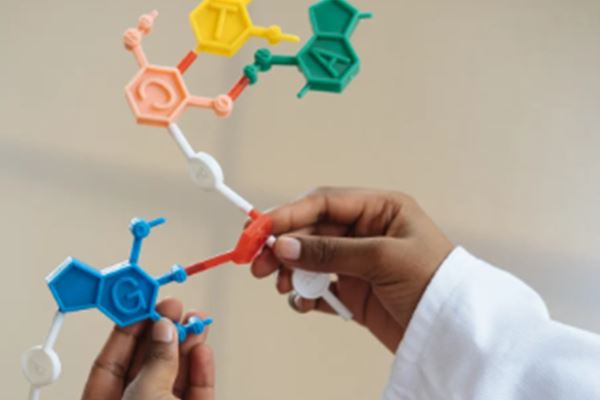Prostate cancer - everything you need to know
14th December 2022
Prostate cancer is the 4th most common cancer in the world. Over 1.4 million people worldwide were diagnosed with the condition in 2020. Thankfully, research is already making enormous progress improving the lives of people with prostate cancer. In the UK today, at least 8 in 10 people diagnosed with prostate cancer will survive for 10 years or more. So what is prostate cancer? How does it begin, and who is most at risk? And how are the donations provided by you already helping to bring new treatments to patients?
What is prostate cancer?
Prostate cancer affects the prostate gland, which is part of the male reproductive system. The prostate gland sits just underneath the bladder, around the top part of the tube which carries urine from the bladder (the urethra).
Cancer develops when prostate cells accumulate DNA damage and begin growing and dividing uncontrollably. A large mass of cells can form, increasing the overall size of the prostate. Eventually the prostate will begin to press on surrounding areas, causing symptoms.

What types of prostate cancer are there?
Much of the prostate is made up of clusters of gland cells which secrete fluid (acinar cells) and small inner tubes which carry fluid (ducts).
Prostate cancers usually begin in the acinar cells and the cells lining ducts in the outer region of the prostate. This type of cancer is called adenocarcinoma of the prostate. Around 9 in 10 prostate cancers are acinar adenocarcinomas. A much smaller proportion are ductal adenocarcinomas and other rarer types of cancer.
What causes prostate cancer?
The exact causes of prostate cancer are not really known so more research is vital to help better understand this disease.
What is known is that it is usually a complex mix of the accumulated DNA damage in prostate cancer cells, combined with other risk factors.
Understanding why some people may be more at risk of developing prostate cancer is a big step forward in learning how best to tackle and treat the disease.

Who is at risk of developing prostate cancer?
Anyone with a prostate can get prostate cancer, including men, trans women, and non‑binary people.
People who have family members with the disease may be at increased risk of developing prostate cancer, suggesting some genetic links. For example, research has already found that people who carry changes to the BRCA2 gene may be more likely to develop prostate cancer.
Other genetic changes are not inherited, but instead can accumulate in cells in the body during the course of a person’s life. This is one reason why age is one of the biggest risk factors for prostate cancer. The longer you live, the more exposure you can have to potentially cancer-causing factors. Cells in older people are also generally less effective at spotting and repairing potential cancer-causing DNA damage.
A very important area of research is investigating why some groups of people seem to have a higher chance of being diagnosed with prostate cancer. For example, in the UK as many as 1 in 4 black men may be diagnosed with prostate cancer in their lifetime, which is double the risk for other groups. Understanding these types of differences can help to ensure the right support is available for those who need it most. It is also the first step in finding ways to reduce this risk.
Symptoms of prostate cancer
Early prostate cancer usually does not produce any noticeable symptoms. This may be why prostate cancers are not usually diagnosed until later in life.
As the cancer grows, it can begin to press on the urethra leading from the bladder. This can cause symptoms such as problems with peeing (urination). These problems might include:
- Difficulty starting peeing, flow stopping and starting, or weaker flow,
- Pain, or blood in pee,
- Needing to go more often (i.e., getting up at night),
- Feeling like the bladder hasn’t emptied properly after going to the toilet.
Not all prostate growths are cancer. Benign prostatic hyperplasia (BPH) is a very common condition which can cause similar symptoms to prostate cancer, but is not usually dangerous. Many people with a prostate develop BPH as they get older. As always, if you have any worries at all it’s always worth asking your GP.

How is prostate cancer diagnosed?
There is no single way of diagnosing prostate cancer and your doctor might carry out a range of tests, including physical examination and blood tests.
The PSA (prostate serum antigen) test is a blood test which measures levels of the PSA protein in your blood. PSA is normally produced by prostate cells. An increase in blood PSA levels can sometimes, though not always, be a sign that cancer may be present. The PSA test is sometimes used as part of screening initiatives to try and detect prostate cancer at an early stage.
In the UK, anyone over 50 can ask their GP for a PSA test, free of charge.
How is prostate cancer treated?
Treatment for prostate cancer can depend on the type, stage (i.e., how far the cancer has progressed), and size of the tumour.
Many prostate cancers are relatively slow growing, and not all prostate cancers require immediate treatment. Some people can live for years without any form of treatment being needed. Instead, they may have regular check-ups and PSA monitoring with their doctor. This is called ‘watchful waiting’.
Local prostate cancers that have not yet spread may be treated with surgery, or other treatments which focus on the immediate area of the cancer. More advanced tumours also require chemotherapy, radiotherapy and other treatments.
Research has also developed other newer types of treatment for prostate cancer, which can be used alongside standard therapies. These treatments include:
Brachytherapy; a type of localised radiotherapy which is delivered to the inside of the prostate cancer,
High-intensity focused ultrasound (HIFU); where high-frequency sound waves are used to penetrate the tumour. The heat generated kills prostate cancer cells,
Cryotherapy; which is used to freeze and kill prostate cancer cells inside the prostate,
Hormone therapies; which work by blocking the stimulating effects of the hormone testosterone (and other androgens) on prostate cancer growth. These therapies can be used to help treat prostate cancers which are early or slow growing, or to shrink the prostate before surgery.
Targeted therapies. These treatments aim to exploit genetic or molecular faults of the cancer cell to stop them growing. ‘PARP inhibitors’ are a type of targeted therapy that can be used to help manage some forms prostate cancer that have faults in the BRCA1 or BRCA2 gene.

How are your donations helping?
Our Curestarter supporters have already played a significant role helping to improve treatment for people with prostate cancer.
Progressing PARP
Back in the 1990s, your vital donations helped researchers push forward the exciting early science behind PARP inhibitors, and make first important steps towards a brand-new cancer treatment called olaparib. First licensed in the mid-2010s, olaparib has now been used to treat more worldwide.
Identifying new cancer drugs
With your help, we were also able to support an innovative research project which tested hundreds of existing drugs for anticancer activity. The researchers found exciting evidence that one drug in particular, mebendazole, has real potential to target prostate cancer when given in combination with chemotherapy.
Improving immunotherapy
Curestarter funding also helped researchers in Argentina identify a ‘molecular brake’ used by cancer cells to evade our immune system, and avoid immunotherapy. The team developed a new treatment strategy based on these findings which could help to make immunotherapies more effective in prostate cancer.
Worldwide Cancer Research continues to fund the most innovative prostate cancer research there is. And we can only do this because of the generosity of our amazing Curestarters. In total, our supporters have helped to fund over £9 million pounds in prostate cancer research, that’s over 75 projects worldwide.
We’re so grateful for your help making sure that brand-new prostate cancer treatments continue to reach patients.
Further reading

‘Game-changing’ treatment for prostate cancer could be available to patients within 4 years
Scientists p have tested close to 1000 existing medicines and discovered that a cheap drug commonly used to treat parasitic worm infection could be a game-changing treatment for prostate cancer.
16 January 2020

Why is cancer so hard to cure?
This is a million, if not a billion, dollar question. With so much money spent on trying to find cures for cancer, why is there not a cure yet? Let’s explore the reasons why cancer is especially hard to cure, but also the reasons to be optimistic.
15 September 2022
